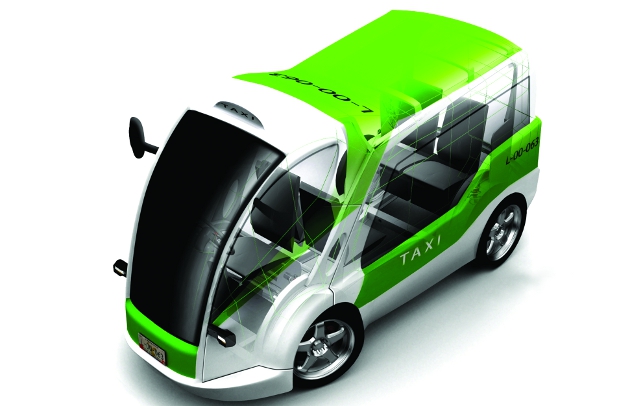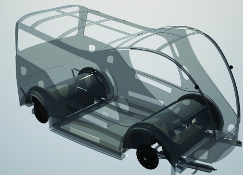With a population of over 23 million inhabitants across the sprawling capital it’s fair to expect that traffic can get a little crowded on the streets of Mexico City. With this in mind the city is putting every effort into developing its modern network of public transport. Whereas densely packed cities such as Tokyo and New York have grown upwards in search of space, the Mexican capital has continued to spread, creating a vast area needing to be connected by a heavily congested interstate.

The Chapulin is shorter in length than a Ford Fiesta. This is down to a space saving design which has no boot and locates the engine under the driver’s seat
Having already upgraded its central metro, one of the busiest and cheapest to use in the world, and with an expanding bus system, the government has now turned its attention to the city’s ranks of taxis. Demanding more than a standard road car with a lick of paint and a meter strapped to its dash, they launched a competition for an innovative, compact and environmentally friendly design. The result? The Chapulín, or grasshopper.
A bug’s life
Resembling a sprightly bug, with its beady, protruding headlights and vibrant colours, it looks set to become as iconic a design as the German designed Volkswagen Beetle that the city produced and took to their hearts. The winning concept came from Mexico City transportation design school Rigoletti Casa de Diseño (RCD), with an accent on Mexican styling. The team consisted of recent graduate Eduardo González Morón, instructor Arturo Millán Martinez, and Juan Antonio Islas Muñoz, RCD’s academic coordinator and also an alumnus.
“We wanted to put some more thought into the experience,” says Islas. “We didn’t want to make just a cool-looking taxi, but one that would meet people’s needs.
“Almost no taxi in the world, except for the London Taxi Cab, was ever designed to be a taxi. They’re all domestic cars adapted for that function. Therefore, they get dirty quite quickly, the passengers’ luggage is never in their sight, and tall and disabled people have problems loading and unloading. Safety considerations for children or pregnant women don’t even figure in typical cabs.
There’s also no security barrier between passenger and driver.”

Conceptual sketches of the Chapulin showing easy passenger access and the variable seating configuratgion
The small and nimble design is shorter in length than a Ford Fiesta, yet manages to incorporate all the design features and functionality expected of modern day inner-city public transport.
Islas goes on to describe how the team focused on keeping the car’s footprint as small as possible, entirely doing away with the boot to allow for a variable seating plan. “We made the most of
the inner space while at the same time making a very small car to move through traffic and manoeuvre into parking.”
Islas and his team drew from their own experience navigating around the bustling streets and highways of Mexico City, a metropolis that still stands as the largest in the Western hemisphere. The metro area of the capital teems with nearly 20 million inhabitants, a greater population than that of Tokyo, and something that is instantly noticeable when you take to the hectic streets.
“Driving in Mexico City is like being a red blood cell trying to pass through a cholesterol-blocked artery,” Islas says. “The number of cars is far greater than the capacity of roadways, and it’s increasing all the time. The condition of those roads is many times less than optimal. People aren’t very respectful to traffic signs, or each other, for that matter. Traffic makes people stressed out. Congestion gives us a cocktail of polluted air and two-hour drives just to get home. It’s part of the reason why we chose to seat the passengers looking at each other, so they can socialise and forget about the long drives.”
Space saving
Getting more cars off the road appears to be one of the positive effects of the Mexico City taxi program, by providing an attractive alternative for residents who would normally own a vehicle. But the compact size of the vehicle frees up some space all by itself.
Over a metre shorter than most normal cabs, replacing all the current taxis with the new version would clear more than 12 kilometres of city street alone. By leaving more floor space for an extra-tall cabin, the wide doors open up to a circular seating arrangement for four, allowing passengers to sit with their luggage, which not only keeps it safe, but also allows for quicker pick-ups and drop-offs. A ramp extends to the curb for wheelchairs, which can then be easily secured during the ride. Passenger seats flip up to make more room for wheelchairs or larger pieces of luggage.

Rhino was used to achieve quality and precision on the exterior styling, but also to model the mechanics, including the chassis and the powertrain
The taxi has also taken into account the need for technological aids for navigation and communication, giving both the passengers and driver a GPS map display for both the driver and the passenger,
instead of vague directions and a dog-eared A-to-Z.
The driver is located in a separate single-seater cockpit, allowing for a wide field of vision through the tall glass frontage, and increased space for the engine unit.
The smog that hovers over the city’s buildings surpasses that of any other in the world and led competition organisers to highlight the need to limit emissions from a vehicle they hope will replace many of the privately owned vehicles on the city streets. As a result the Chapulín operates on a hybrid diesel-electric system, cutting out street-level exhaust. “What is particularly unique for this hybrid is that the diesel engine acts mainly as an electric generator for the batteries, rather than a traction aid,” explains Islas. “This allows us to keep the mechanics very compact. If you look at some of the renderings, it would appear we forgot about the engine, but no, it’s under the driver’s seat.”
Our design was the one that best merged function and styling. The government in Mexico City wanted an icon for the city, and that is what we intended in the first place
Mexico City has already adopted drastic measures to reduce congestion and pollution caused by the vast amounts of traffic with mixed results. Hoy No Circula, a system limiting access for cars to the roads one day a week according to their registration number has been deemed unpopular – with many of the affluent inhabitants simply buying another car to get round the problem, at the same time increasing the amount of cars on the roads and adding to the amount of pollution caused. Eco-friendly public transport seems to be the only way to combat the haze of exhaust fumes.
Manufacture was another key concept for the winning design that would benefit the city. “Our idea was to produce it as a kit-car. It would be assembled by small certified workshops, which would generate employment. Another important consideration for the city was that it wanted to produce the cab – something we didn’t know when we made our submission – so when we already had 3D models for the powertrain, I guess they thought the design development was taken further than other proposals.”
The team from RCD claim that their entire design, from first ideas through to renderings, was completed in little more than two weeks, which seems to complement the simplistic styling and features.
From concept to CAD
When they had reached what they wanted in terms of functionality, they put their ideas into CAD using Rhinoceros to create the general shape of the interior and exterior. “With Rhino, we could get great quality and precision on the exterior styling, and also model the mechanics, like the chassis and the powertrain.” Printed screenshots of the 3D model were then sketched over by hand, rather than creating full renderings, giving a loose expression of the interior features and saving time in the rush for submission.
After the award, the city now owns the rights to the design. Islas expects that the city will hire them to do further design development as the project goes into engineering and production stages. “Now we have gone back without time restrictions and made a more refined Rhino model and renderings with more details worked out. The Mexico City government can then add engineering specifications to the model as it begins production of the prototypes.”
The government plans to make two or three prototypes of the Chapulín and perform test-runs. After that, it intends to produce 12,000 cabs a year, until the goal of 120,000 taxis citywide is reached.
The young designers were thrilled to win such a large project, especially in their home city. “I think we won because our design was the one that best merged functionality and styling. The government
in Mexico City wanted an icon for the city, and that is what we intended in the first place. Chapulín means grasshopper, an insect that relates to Mexico City’s identity in word Chapultepec.”
Meaning ‘at the grasshopper hill’ in the Nahuatl language, Chapultepec is the name given to large hill on the outskirts of the city and has represented a special place for Mexicans throughout history.
Mexican culture is referred to prominently by the RCD, with its strong influence being visible in the vehicles they produce. The design school is beginning to feature more often in transport design contests around the globe. Both students and teachers have in recent years claimed top spots in competitions such as the Peugeot Design Contest and won internships to Alfa Romeo, Fiat, and Nissan amongst others.
Part of this design brief on their home turf was to design a taxi that would not only help confront the city’s transport problems, but also to create an internationally recognisable symbol of the city’s identity.When put into production on the scale expected, a swarm of 120,000 Chapulín chirping through the city streets should add to the bright, colourful and vibrant character of the city, making the grasshopper the new iconic car on the roads of the modern Mexican metropolis.
Hop on a grasshopper when travelling in Mexico City






